Supporting Families of Young Children With Disabilities Using Technology
Early Childhood Assistive Technology
The Benefits of Screen Fourth dimension for Immature Children
Earlier the increased utilise of computers, smart phones, and tablet devices, screen time was defined as passively sitting in front of a television. Today, newer technologies are evolving and advances happen chop-chop. There is anecdotal evidence showing that screen fourth dimension tin accept a positive impact for all children. However, it should always support positive parent-kid relationships.
Apps Reinforce Learning
For some children with disabilities, technology can give them a voice in the course of an augmentative and alternative communication (AAC) organization and open new doors of possibility. For others, it tin provide resource that aid children anticipate what is coming next and what is expected of them.
Additionally, there are countless applications that enhance and reinforce learning, social skills, play, and linguistic communication and advice.
Engineering science Tin Be Motivating
Digital, interactive media — such equally applications or devices — can exist highly motivating. It can boost skill development when used in appropriate amounts and with appropriate supervision.
PACER's Simon Engineering science Center provides guidance for early on babyhood educators on the utilize of technology in means that support young children's cognitive, social, emotional, concrete, and linguistic development.
Residuum is Key
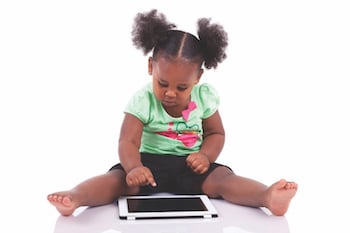
Contiguous interaction between parents and children is very important. All children should have many opportunities to play and explore when tablet or smart telephone screens are turned off.
Finding a way to balance the employ of technology may be challenging for some families. Below are a few tips to try:
- Apply engineering purposefully for learning.
- Choose apps or devices based on the content. Contact PACER's Simon Engineering Center for information about those that can support your child's development.
- Connect the content in apps and activities to a child's existent life experiences. If your kid enjoys an app with the ABCs, point out messages while at the store and sing the songs played in the app.
- Create rules and construction around engineering science utilize. Take engineering-gratis areas and limit technology apply to certain times of day. (An exception to this would be for children who use technology equally their method of communication or to reduce anxiety.)
- Model responsible technology use by following the same rules! If your children aren't allowed to apply applied science during dinner, make sure you lot put your devices away, too.
- Maximize the time yous already apply technology to connect with other parents online, or follow blogs of parents or professionals using similar engineering science. Search Facebook or Pinterest for activities to relish with your kids when the screen turns off.
Technology is Ane Tool
Mobile devices comprise features that provide children and adults a wealth of educational and engaging material to which they may not otherwise have had access due to concrete, behavioral, or social limitations.
These devices can exercise things as circuitous every bit providing a way to communicate and as simple as being a conversation starter betwixt children. Technology is a tool, and like any tool its effectiveness and value is determined by how it is used.
Accept It Out for a Test Drive at PACER's A.T. Lending Library
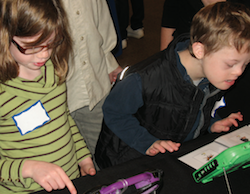
For children and young adults with disabilities, discovering the correct assistive technology (AT) tin be life-irresolute. Thanks to the resources of the Lending Library at PACER'due south Simon Technology Center (STC), families and professionals can larn nigh the latest technology and have it domicile for a trial run. Lending library members tin infringe as many as six items at a time for as long as four weeks.
An online catalog — AT Finder — enables members to search items available for loan. Categories include software for reading, writing, math, independent living skills, apps, and more. AT devices include touch screens, switches, alternative keyboards, and communications devices.
The library has a wide range of mobile AT apps, and members tin infringe an iPad to endeavour these applications at dwelling house including AudioNote, which Augsburg College student Sam Graves uses to record lectures. "Information technology has been extremely useful to me since it takes me a while to write," said Graves, who has cerebral palsy. "I have been coming to the STC since I was 3 years quondam and accept had great experiences in that location."
The STC has recently added some heady new technology, including the VGo Robot, the UbiDuo Wireless Face-to-Face Communicator, and the Tobii Center Mobile, state-of-the-art devices that tin dramatically improve the quality of life for individuals with a wide range of disabilities.
Lending library members are encouraged to provide feedback and submit reviews. "Because of the library I bought a Livescribe smart pen and was able to access the Co:Writer app. What a wonderful resource!" i parent wrote. A professional who uses the lending library said, "I appreciate the efficiency of the loan and the availability of the devices. My client loved the new features (of the device) and Medicare covered the toll!"
For more information, visit PACER.org/stc or call 952-838-9000.
Resource
- Project KITE - Kids Included through Engineering are Enriched
A costless assistive technology grooming and coaching program for Minnesota parents and educators designed to increase the independence and inclusion of young learners with disabilities.
- TIKES - Technology to Amend Kids' Educational Success
Assistive technology, whether something as unproblematic as a pencil grip or equally complicated as a communication device, has the power to alter lives and opens doors of opportunity for people with disabilities. The TIKES Projection helps to open these doors for parents and providers past educating them on and promoting the use of assistive technology with children and students with disabilities ages birth to v. Assistive engineering science tin can back up immature children in building skills, increasing participation in activities, promoting evolution, enhancing learning, and boosting self-esteem.
- Introduction to Assistive Applied science for Early Childhood
Do-It-Yourself: Assistive Technology Devices Fabricated at Home
Assistive engineering doesn't need to be expensive or sophisticated to make a positive divergence in the life of a kid with a disability. Sometimes the most effective devices can be built at domicile by do-it-yourself moms and dads. Hither are a few examples worth exploring.
Object Calendar
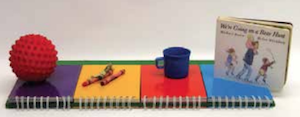
Transitions from 1 activeness to the side by side can be difficult, especially afterwards preferred activities like playtime and story time. When information technology'south time to clean up or start a new activity, help brand the transition easier with an object calendar. The object calendar will assist your child anticipate what activeness comes next. Divide a small-scale shelf or a board into sections using masking record. Y'all tin can place objects representing an activeness on a shelf or board divided into sections using masking tape. The number of sections depends on how many activities volition be in your child's schedule. Notice small objects that represent those activities. For example, toy food could stand for lunch fourth dimension, or a doll'south pillow could represent nap time. Put the objects in the correct sequence on the advisable section of the divided shelf. Once the activity has concluded, your child can place a dish towel over the object to show that the activity is "all done."
Advice Key Concatenation
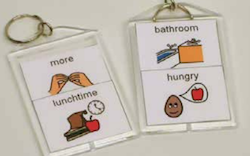
Electronic advice devices tin't always be taken everywhere—like to the pool or to a park—but without a fashion to communicate, your kid may get frustrated and throw a tantrum. This advice fundamental concatenation will let your kid to share food and action choices without having a trouble. First, create several moving-picture show communication symbols, impress them out, laminate or place them in a clear key concatenation, and attach the key concatenation to your child's chugalug loop or backpack zipper.
Adapted Grip
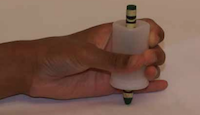
Some crayons, markers, or utensils may be hard for your child to concord. This adaptation tin can be used in coloring activities and to aid brand mealtime less messy. Use empty prescription bottles or an old 35 mm motion-picture show container and remove the lesser of the container with a scissors. Insert the utensil or crayon into the hole and anchor it by placing playdough or modeling dirt inside the container.
iLearn, iGrow, iPlay: New Engineering science Benefits Young Children with Disabilities
2011
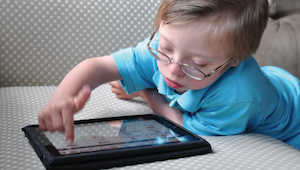
Until vi months ago, v-year-sometime Leo Foley, who has Down's syndrome, communicated primarily through sign linguistic communication. When his mother, Brenda, couldn't sympathize a sign, he would get upset and commencement having tantrums. The situation was frustrating for both Leo and the entire family, Brenda says.
"We but could not always figure out what he wanted," she says. "Sign language was working, just we didn't e'er know the signs that he knew. One nighttime he was actually, really upset, and we simply could not figure out what to practice."
That's when she decided to buy Leo an iPad to help him communicate. At present, when Leo needs or wants something, he uses his iPad, customized with pictures and phrases such as "I'grand hungry" or "I need to get to the bathroom," to tell his parents. Considering his parents can easily understand him at present, Leo's behaviors have become more positive.
"It has improved his ability to let us know what he needs," she says. "With the iPad, there are and then many communication possibilities that it's nearly unlimited."
Although the iPad has been on the market for less than two years, it's become a very popular device for people with disabilities. Some of its factors—such as its easy-to-employ touch screen and thousands of cheap applications ("apps")—make it a quality assistive technology device for young children with disabilities every bit well.
In add-on to the iPad, at that place's also the smaller iPod touch or iPhone, both of which offer similar features and apps, likewise as other smart phones, such as the Android or Blackberry. All of these devices offer apps for young children, with many specifically for children with disabilities. Due east-book readers, such as the Kindle or Nook, also take educational games for young children.
These devices offering many benefits for young children with disabilities, especially for children with speech or language delays, autism, or developmental delays. They are customizable, lightweight, and appealing to all children, both with and without disabilities. They can also help increase a child'southward independence and participation in early on childhood settings, such as dwelling or child care. Certain apps, such every bit Proloque2Go for the iPad, help children communicate through pictures on the screen. Other apps utilise videos to teach children social skills.
For Minnesota parents looking into the iPad or iPod bear on, PACER'south Simon Engineering Centre (STC) Lending Library has both devices bachelor for families to check out before purchasing. Parents tin make an appointment with the STC by visiting PACER.org/stc or calling 952-838-9000. The STC too holds workshops throughout the year on iPod/iPad apps for children with disabilities.
"Before we had the iPad, I used the STC Library several times," Brenda says. "They gave u.s. such cracking ideas. They really understand what kids similar, and they know so much."
Deciding on a Device
Because there are and then many assistive technology devices available, it'southward important to consider all options before acquiring an iPad, iPod touch, or other similar device. Families should ask:
- What is my child's need?
- How will my child employ the device?
- How volition my child access the device?
- How much retention exercise I need?
- Who will own the device, the family or the school? If the school obtains the device for your child, talk over this question with the Individualized Education Program (IEP) squad.
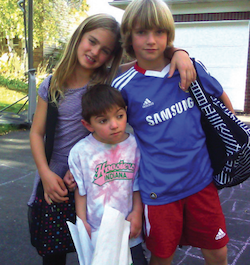
Mike and Carolyn Thomson's 5-year-old son Finn has Cornelia de Lange Syndrome, a rare genetic disorder. They have been considering the iPad for several months equally a advice device for Finn. Because he also has poor motor skills, Mike and Carolyn believe the iPad's larger size and sensitive touch screen would piece of work best for him.
"For Finn, the larger tablet would be nearly conducive to his learning and would too aid him communicate," Mike says. "He could show us when he's hurt or hungry, and we could respond immediately. Communication is our biggest challenge by far, and I recollect the iPad will greatly improve his quality of life."
Tonya Hilyard, whose iii-yr-old son Sam has speech communication apraxia, is likewise thinking the iPad could replace Sam's selection board as his main method of communication.
"I'm waiting until we write his IEP and we can see exactly where the demand is," Tonya says. "I believe the iPad would help him communicate better and help anybody empathize him better."
Sam already uses the Nook Color, Barnes & Noble's e-book reader, to play educational games. "I have puzzles and apps for learning colors and letters," Tonya says. "If he answers a question correctly, there are fireworks on the screen. It'south great to see him receive praise for doing it correctly." To make sure the iPad will be the best choice for Sam, Tonya plans to visit PACER'due south Simon Technology Eye and compare similar assistive technology devices.
"I want to rule everything else out before I decide on something," Tonya says. "I just want to find what volition work all-time for him."
What works best will vary from family unit to family, depending on a child'southward needs. Katie Duff has found that her 4-yr-former daughter Macy benefits from using Skype, a website that offers free video calling through estimator webcams. Macy, who has a visual impairment with subsequent motor delays and apraxia of voice communication, didn't similar to talk on the phone to her gramps, who lives in Houston, Texas. While her receptive linguistic communication was good, she had trouble expressing herself and would "just mumble on the telephone," Katie recalls.
Using Skype, even so, Macy tin can see and talk to her grandfather at the same time, making it a much different experience. "On Skype, she'southward so lively and interactive," Katie says. While they talk, Macy'due south grandfather also includes some learning exercises, such as holding up flashcards and asking her to spell the object on the card.
"She probably wouldn't have the relationship she has with her grandfather if it weren't for Skype," she says. "The sky'southward the limit with what you can do on Skype."
The Sky'south the Limit
Similar Katie Duff, many parents and professionals are realizing the sky's the limit with these new technologies, specially for young children with disabilities. "The way technology is going, it'south making it easier for kids who wouldn't have learned to communicate otherwise," Mike Thomson says. "Many parents understand the desperation of trying outlets that come short. That's why this technology is so inspiring."
Katie, who has used unlike devices with Macy, including Skype and the iPad, predicts that technology will play a big role in Macy's life for years to come.
"This technology is empowering for kids with disabilities," she says. "They need something they can exercise themselves and be proud of. I don't desire annihilation to cease my daughter, and I know engineering will be a big part of that throughout her life."
jackmanunshes1939.blogspot.com
Source: https://www.pacer.org/ec/assistive-technology/
Postar um comentário for "Supporting Families of Young Children With Disabilities Using Technology"